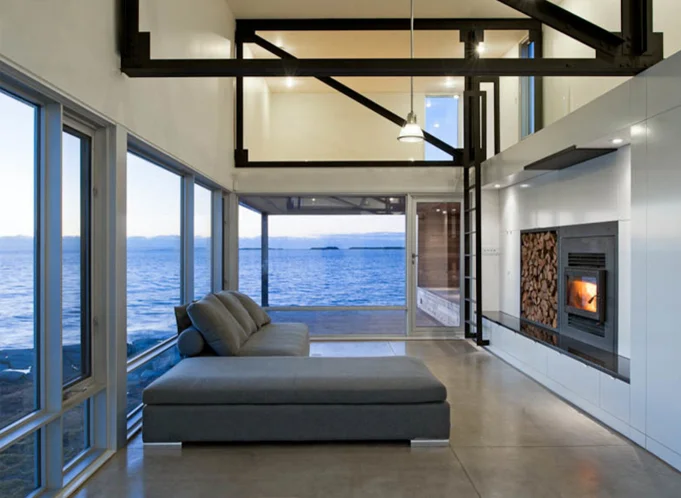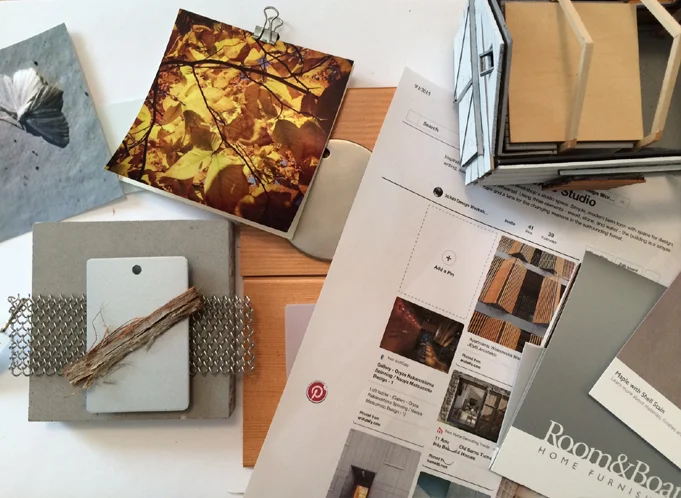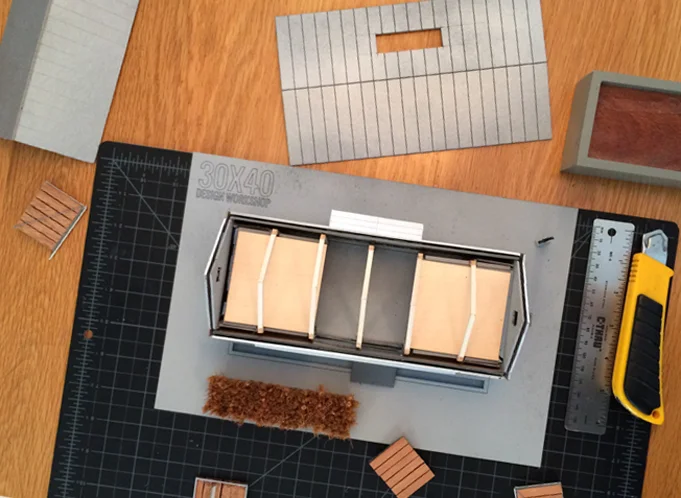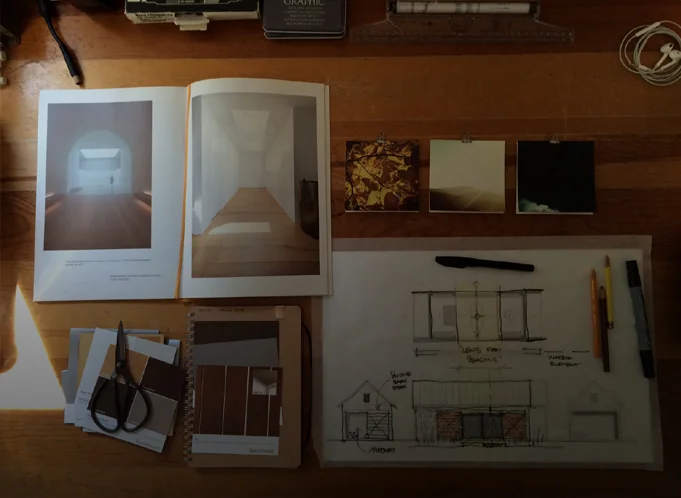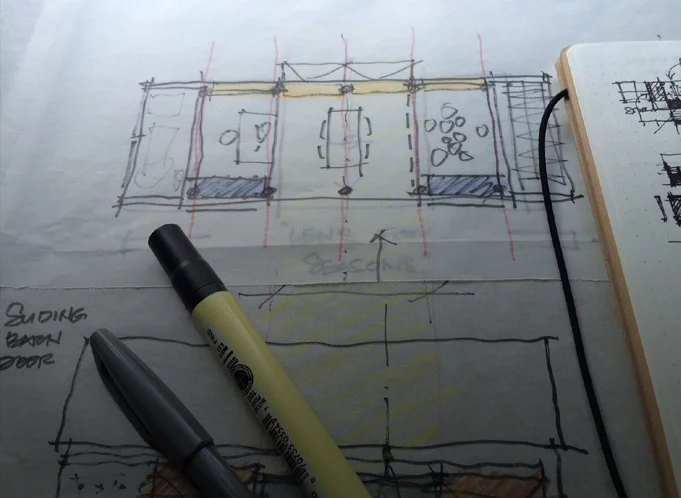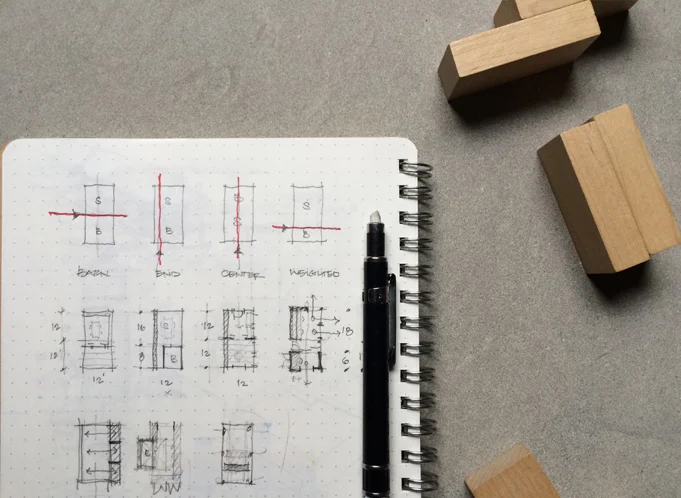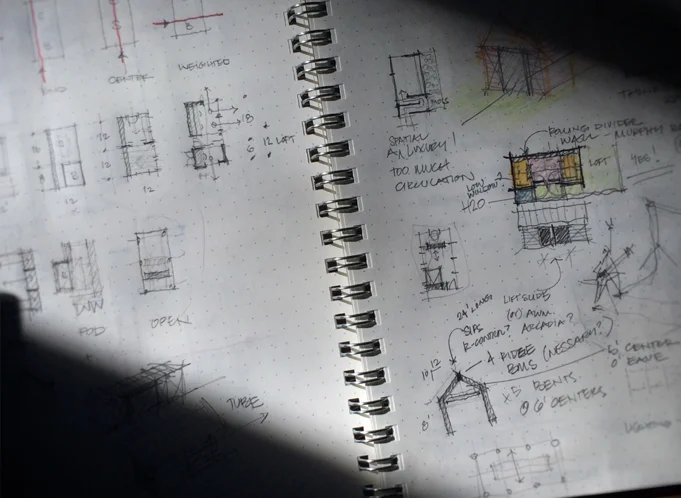In this video I explore four homes built on boundaries. It's a look at how a home can challenge the natural environment and occupy the boundary between architectural convention and stunning natural beauty. When confronted with a design brief and an undeveloped site, architects often look to the edges of that site for inspiration and meaningful architectural solutions. These boundaries, both real and imagined, are exciting places to build. The boundary often gives rise to the form of the building, its materials and even how it’s structured.
Designing a Small Studio - Selecting Materials (Part 6)
Materials can be used to convey the underlying concept of a building or in some cases they can function as the entire concept (Peter Zumthor is an excellent example). In this video I detail the process I used for connecting the "lens for the seasons" and "barn" concepts to an attitude about building materials.
I begin with abstract imagery, then build Pinterest boards with inspirational images, then I gather and collage materials. Instead of directly quoting the Pinterest images I draw upon their essential ideas to develop the material palette for the building.
The concepts are hard to compress into a short video (my apologies) if you stay tuned to the end I talk about a quick tip for securing free material samples I recently discovered.
How to Borrow Light
In this video I discuss natural daylighting strategies anyone can take advantage of. I begin with a short history lesson which describes how daylighting actually shaped the largest of cities in the US. In 1915 the 38-story Equitable Building in New York City was the largest office building in the world. Containing 1.2 million square feet of office space, it consumed nearly every available square foot of its diminutive lot and cast an equally large shadow on its neighborhood in lower Manhattan. Its construction inspired the enactment of the city’s 1916 Zoning Resolution, which was designed to preserve access to light and air at the street level. The resolution prescribed specific limitations for a building’s envelope — its outer walls — and would go on to shape the stepped forms that you see today on many of the iconic towers in the city.
This underscores the importance that access to daylight had in shaping even the largest of cities, the individual buildings that make up those cities and, more broadly, sensible building design. With an increasing focus on sustainable design practices, the smart use of natural daylight in our homes is no longer a luxury — it has become a necessity. At the heart of any good daylighting strategy is a concept of “borrowed” light: the capture of light falling on the exterior of a home and transporting it to the spaces where it’s needed.
Designing a Small Studio - Building a Study Model (Part 5)
In this video I discuss the benefits of building a small scale, physical study model using the reference project I've been designing: my studio building. Computer models are excellent tools, but simple cardboard models allow real-time manipulation of forms and the development of ideas that don't always present themselves when working in a digital environment.
For me, model building has always been a part of the design process. They help: 1) To study building forms and spaces. 2) For real-time solar studies. 3) With envisioning scale of elements as they relate to the human form. 4) Allow one to explore a variety of material and color options, quickly and easily. 5) One can quickly flesh out ideas in much the same way a hand sketch might, however, model construction uniquely forces you to make decisions about building elements that sketching doesn't.
Future videos will describe sketchy model building hacks and tactics to more quickly build a useful avatar for your architectural project.
Craft. Architecture. 10 Thoughts.
In this video essay on craft and modern architecture, I offer ten reasons to integrate craft in your design.
Designing a Small Studio - Revisiting and Integrating the Concept (Part 4)
In this video I overlay the plan diagrams on the site plan which reveals a clear favorite. I go on to describe 6 tactics I use to turn a simple diagram into a meaningful floor plan. They are:
1) Study a building precedent (in this case a barn).
2) Develop an ordering system (grid, column layout, geometry, functional). Once it's established you can decide when to "disobey" the rules.
3) Create zones: entry, circulation, storage, living. Divide public and private spaces.
4) Analyze adjacencies - group common functions and support spaces. Make sure their orientation makes sense for the plan location.
5) Refer back to the concept. In this case the "lens for the seasons" concept reinforced the barn plan typology and spurred on new ideas.
6) Create layers of meaning. Begin by thinking about the way we experience space or places and look for opportunities for the building to enhance daily life.
The next video explores the use of small physical study models for solar, material, and proportioning studies.
Designing a Small Studio - Plan Diagrams (Part 3)
Part 3 in a multi-part video series where I dissect the design process for a small studio space. In this video I sketch out the four basic plan ideas I generated for the studio and describe the benefits and liabilities of each. Designing a floor plan begins with an understanding of the site, where the sun is, the winds, the approach, public and private areas and a precise listing of the spaces to be incorporated.
A well-designed floor plan synthesizes all of this information into a simple, logical connection of rooms. The process I describe works for buildings that are extremely simple - such as my studio - as well as very complex structures.
Designing a Small Studio - Site Diagrams + Plan Size (Part 2)
Part 2 in a multi-part video series where I dissect the design process for a small studio space. In this video I discuss site diagrams, zoning, and the process I use to determine the overall size of the project.
Designing a Small Studio - Inspiration (Part 1)
In this video I discuss the inspiration for the design of my small studio and workshop here on Mount Desert Island. This is part 1 in a multi-part series I've been recording as I continue to refine the design and prepare for the construction of this project. Part 1 discusses the site inspiration and how living on the coast of Maine has informed my design process. My work is site specific, narrative based and craft-driven; these concepts appear continually in my work and I hope this video offers some insight into how these abstract ideas develop into architecture. In part 2, I sketch out the plan concepts and parse the options to show you how I typically begin a project and move through the various options.
Ethanol Fireplaces - An Architect's Review
Two common alternatives to the traditional fireplace that have been gaining favor with consumers ready for a simpler installation, lower maintenance and ease of use are the ethanol and gel-fueled fireplaces. If you’re considering purchasing one, this video describes everything you need to know. In it, I discuss costs, configurations, types, layout, and fuels along with a few caveats.
Concealing the Garage
Cars are among the largest physical objects we own, which helps us rationalize the generous square footage we allocate to them on our property and in our homes. Because of their size, they’re not an easy aesthetic problem to solve. Architects and designers have always struggled with how best to orient the mass and large footprint of the garage. Detached, connected, trellised, to the side, to the rear, beneath — every possible location requires compromise. In this video I discuss various strategies to conceal the garage. In hopes that we can move beyond arriving to the garage door rather than the porch or the front door.
Accessory Dwelling Units
In this video I review the the accessory dwelling unit (ADU), which is an additional, self-contained home located either within or adjacent to an existing house. They're also known as in-law units, granny flats, multigenerational homes, and laneway houses. These offer a compelling solution to the problem of suburban sprawl and are an excellent means of increasing the utilization of existing municipal infrastructure.
I discuss the permitting procedures, restrictions, and general planning framework for the ADU, where to start and the costs involved.
Resources mentioned in the video:
Design Inspirations
This is a short list of the threads and inspirations that have been influencing my work lately. Some lurk just beneath the surface, waiting for the right opportunity, the right site or the right client, while others are more thematic and make appearances again and again. I hope they’ll help to replenish your creative stores and inspire you to see the world around you through a new lens.
Modern Baseboard Design - 4 Ways
In this video I discuss four modern design attitudes toward the baseboard design and detailing in residential architecture. They are: no base, reveal base, flush base, and the applied base. Baseboard protects a highly trafficked (and abused) part of the home and covers the messy joint between the finished wall and floor. This collection of modern base details highlights the aesthetic language of modernism: functional, spare, humble, minimalist and expressive.
For modern baseboard details I've designed see:
The Dogtrot House Plan Origin Story
In this video I discuss the origins of the dogtrot as a plan archetype, its history and how it came to be. Although commonly thought of as a Southern building type early settlers of Pennsylvania and New Jersey, the Swedes and Finns brought with them the "pair cottage" from Northern Europe. This shaped the early dogtrots in the United States. It was widely adopted in the South because is offered an ingenious method of passively cooling the home. This is the first of a three-part video series. In part 2 I discuss the design process for the modern dogtrot floor plans I've developed which were inspired by these early prototypes.
Modern Fireplace Design - Concepts and Ideas
In this video I review and contrast two distinct approaches for designing the essential architectural elements of the modern fireplace. Each concept is illustrated with a contemporary architectural example. By intentionally emphasizing or minimizing different components varying effects can be achieved.
For more fireplace images see here.
Industrial Style - Metal Mesh for the Home
In this video I discuss how to put metal mesh to work in your home. I'm always searching for new materials to use in my residential work. I’m particularly drawn to adapting simple, utilitarian, industrial materials for use in the home. Industrial metal mesh is an excellent example of this and one that deserves consideration for both interior and exterior use. In the video I review the different types of mesh available from bar grating and metal fabrics to screening and wire meshes. I discuss the substrates and specific applications. Each is illustrated with images depicting their use.
Phased Construction for Residential Construction
In this video I discuss the advantages and disadvantages of phasing your home construction project. Phasing intentionally and selectively plans for and delays certain aspects of a home's construction. While it saves money up front, it usually costs more in the long-term. The advantages of phased construction are:
- Lower Initial Investment - it takes less overall to get started and can spread the costs of a larger project out over time.
- Shorter Construction Time - the smaller scope of work nets a reduced (initial) construction timeline.
- Experience - living in a partially completed home while its under construction not only offsets living costs but allows you to truly experience the size and scale of the home before undertaking future phases.
- Design Changes - phasing opens the door to pivoting design ideas over time. You may decide you don't want the detached guest house planned in phase two, rather you want it incorporated into the home as an addition.
The disadvantages are:
- Complexity - overall phased construction is more complex.
- Longer Total Construction Time - even though the initial construction sequence is shorter it will take longer to realize the entire project.
- Higher Total Cost - because of the longer time frames involved, financing costs, higher design fees and the extra mobilization costs, phased projects are inherently more costly to undertake.
I discuss the details of financing concerns, planning issues, sequencing, phasing plans, staging, scheduling, and living with the mess of construction.
Phasing is an overall more complex process, but it makes sense in certain cases, the video explains those cases supported with lots of visuals.
Garage Style Doors for the Home
In this video I review new ways to put the common garage door to use around your home. I review the types of garage doors: pivoting, sectional, and coiling as well as the materials, hardware options and special considerations you'll want to review before committing to using this design element in your home. The images offer proof that the overhead door doesn't have to be relegated to only the garage anymore.
How to Separate Space in an Open Floor Plan
In this video I review seven of the most common tricks I use as an architect to separate space in an open floor plan. I talk about the advantages and disadvantages of each including: the room within a room concept, open shelving, thin wall planes, thick wall masses, sliding walls, fabrics (metal and cloth), and hybrid systems.

